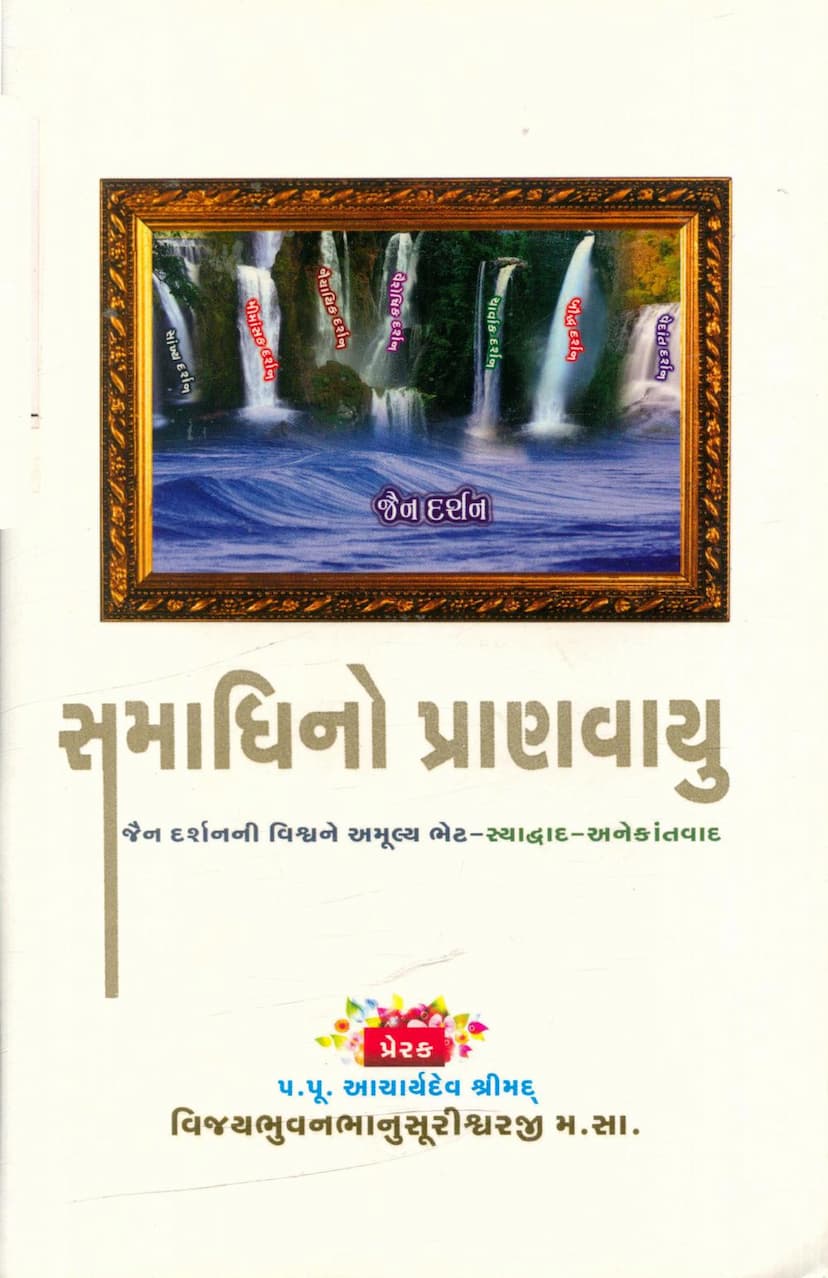Samadhino Pranvayu
Added to library: September 2, 2025

Summary
This comprehensive summary of "Samadhino Pranvayu" (The Life-Breath of Equanimity) aims to provide an overview of its key philosophical concepts, particularly focusing on the Jain principles of Syadvada and Anekantavada.
The book, inspired by the teachings of Acharyadev Shrimad Vijaybhuvanbhanusurishwarji Maharajasaheb, is authored by Acharyadev Shrimad Vijayajitshekharsurishwarji Maharajasaheb and compiled by Panyasji Shrimad Sanyambodhivijayji Maharajasaheb. Published by Jainam Parivar, it is presented as a foundational text in a series aimed at making Jain philosophy accessible.
Core Concepts and Themes:
- Syadvada and Anekantavada as Priceless Gifts: The book prominently highlights Syadvada (the doctrine of conditional predication) and Anekantavada (the doctrine of manifoldness or non-absolutism) as the core, invaluable contributions of Jain philosophy to the world.
- The Nature of Reality: Anekantavada is presented as the principle that every substance possesses infinite qualities. The book elaborates on this by explaining that a single entity can be considered existent (sat) and non-existent (asat) from different perspectives (own-substance, time, place, state, and others). Substances are described as both eternal (nitya) in their underlying essence (dravya) and transient (anitya) in their manifestations or forms (paryaya). This inherent duality and multiplicity of perspectives form the bedrock of Anekantavada.
- The Importance of "Syat": The word "Syat" (meaning "perhaps," "in some sense," or "from a certain viewpoint") is crucial to Syadvada, as it qualifies any statement, acknowledging that it represents only one aspect of a multifaceted reality. The book emphasizes that neglecting "Syat" leads to absolutist viewpoints, which are considered incomplete and misleading. The famous "Saptabhangi" (the sevenfold predicate) is presented as the logical extension of Syadvada, providing a framework for expressing the complex nature of reality from multiple viewpoints.
- Critique of Ekantavada (Absolutism): The text strongly critiques various forms of Ekantavada (e.g., eternalism, nihilism, momentaryism) prevalent in other philosophical schools. It argues that these one-sided views fail to grasp the complete truth and lead to intellectual rigidity, conflict, and a limited understanding of the world. The book illustrates how by clinging to a single perspective, these schools create inherent contradictions and limitations.
- Benefits of Anekantavada: The practical benefits of adopting an Anekantavada perspective are extensively discussed. These include:
- Broadened Vision and Intellectual Generosity: Fostering an open-mindedness and the ability to understand the reasons behind others' beliefs, leading to greater tolerance and reduced dogmatism.
- Reduced Attachment and Suffering: Recognizing the transient nature of material possessions and worldly experiences (anicca/kshana bhangurata) helps in weakening attachment, a primary source of suffering.
- Cultivation of Equanimity (Samata): By viewing dualities like pleasure and pain, gain and loss, honor and dishonor, as inherent aspects of existence, one can develop equanimity, leading to inner peace and a reduction in conflict.
- The Path to Liberation: Equanimity, born from the understanding of Anekantavada, is presented as the direct path to spiritual liberation (moksha).
- The Role of Nayas (Standpoints): The book delves into the concept of "Nayas," which are specific standpoints or perspectives used to understand different aspects of reality. It explains how Nayas, when used correctly, contribute to the comprehensive understanding of Anekantavada. The text discusses various classifications of Nayas (e.g., dravyarthika, paryayarthika, sangraha, vyavahara, rujusutra, etc.) and warns against "Nayaabhasas" (fallacious Nayas) that distort truth by misinterpreting or misapplying these standpoints.
- The "Saptabhangi" (Sevenfold Predicate): The book provides a detailed explanation of the Saptabhangi, illustrating how it systematically captures different facets of reality. The seven propositions are explained through examples, demonstrating how seemingly contradictory attributes can coexist in a single entity when viewed from different angles.
- Reconciliation of Apparent Contradictions: Syadvada and Anekantavada provide a framework for resolving apparent contradictions in philosophy and life. The book uses analogies like the blind men and the elephant, or the half-full/half-empty glass, to illustrate how different perspectives can lead to different, yet valid, conclusions.
- The Importance of "Pramana" (Valid Knowledge): The text emphasizes that while Nayas offer partial truths, only "Pramana" (valid, all-encompassing knowledge, ultimately exemplified by Keval-jnana or omniscience) provides the complete picture. Syadvada, with its qualifying "Syat," helps in distinguishing between partial truths (Nayas) and complete truth (Pramana).
- The Nature of the Soul (Atma): The book discusses the Jain understanding of the soul, explaining its simultaneous eternality in essence and transience in states, its subtle yet body-pervading nature, and its potential for liberation through the shedding of karmic impurities.
- Critique of other Philosophical Schools: Throughout the text, the author engages in philosophical discourse, presenting and then refuting the absolutist claims of other philosophical systems, thereby reinforcing the superiority of the Anekantavada approach.
- The Essence of Jain Practice: The underlying message is that living according to the principles of Anekantavada fosters inner peace, equanimity, and ultimately leads to spiritual liberation. The book encourages a balanced and comprehensive approach to understanding reality and conducting oneself in life, devoid of dogmatism and conflict.
Overall Message:
"Samadhino Pranvayu" is a profound exploration of the philosophical underpinnings of Jainism. It aims to equip the reader with a nuanced understanding of Syadvada and Anekantavada, not just as intellectual doctrines but as practical guides for achieving inner peace, clarity, and spiritual advancement. The book champions a worldview that embraces complexity, rejects rigid absolutism, and promotes tolerance, understanding, and ultimately, liberation.